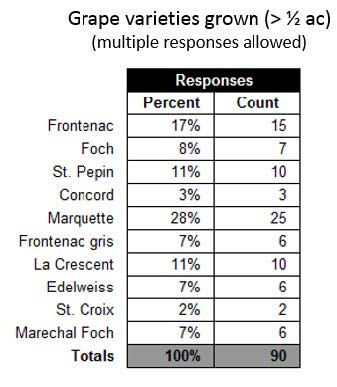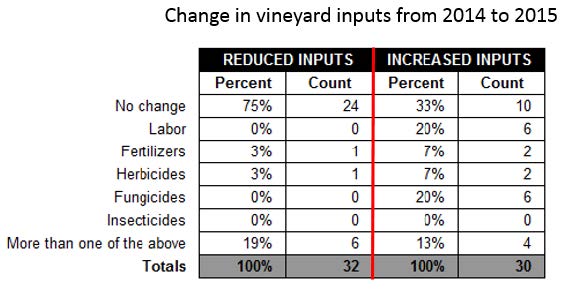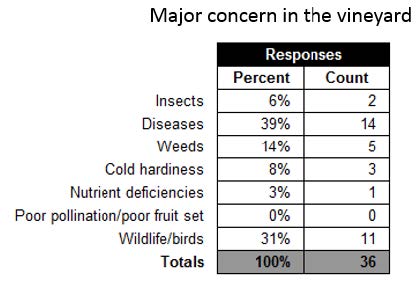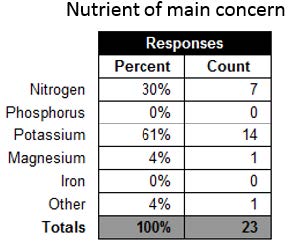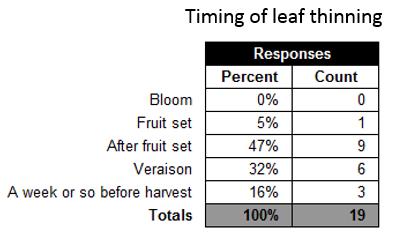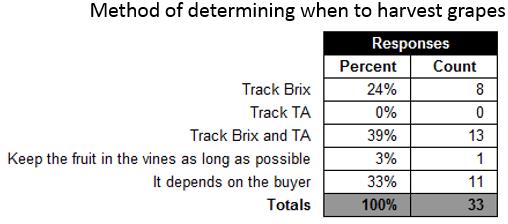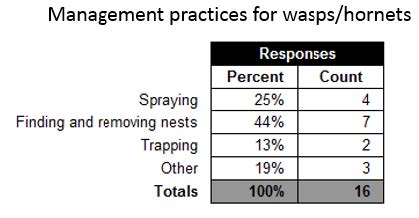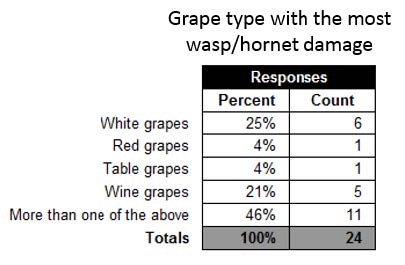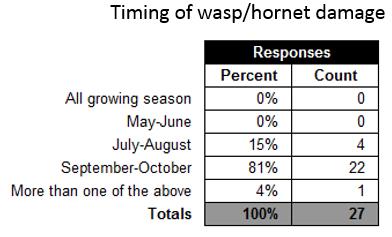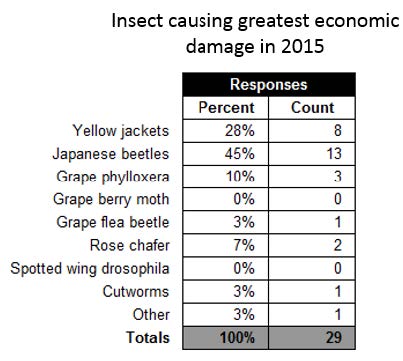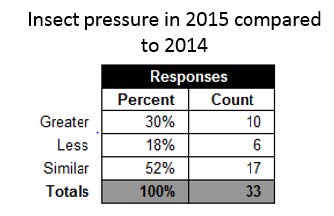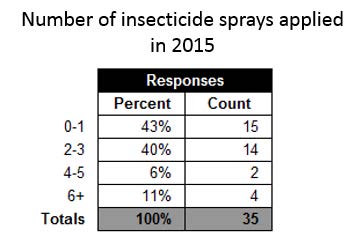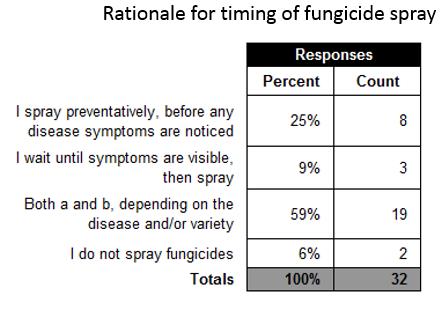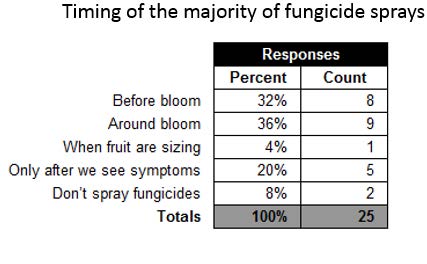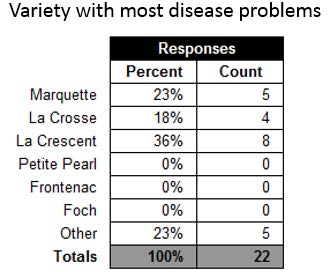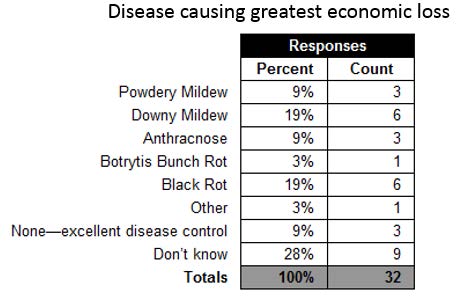WFFVC Grape Grower Survey Results 2016
On January 26, 2016, attendees of the Grape Track at the 2016 Wisconsin Fresh Fruit and Vegetable Growers Conference held in the Wisconsin Dells had the opportunity to participate in an interactive survey The information from this session allows growers to see what practices or problems others are experiencing, as well as informing researchers what research topics should be their priority. The following report summarizes the survey results broken into sections of farm demographics and management practices, then followed by horticultural, insect, and disease-specific topics. In the tables, the “count” column indicates the number of respondents and the “percent” column indicates the % of respondents.
FARM DEMOGRAPHICS: The attending growers are from farms spread fairly evenly throughout the state (n=36). The acres of grapes grown in each vineyard was: 21% grow less than 0.5 ac, 28% grow 1-2 ac, 28% grow 3-4 ac and 23% grow 5 or more acres (n=39). In the next two years, those numbers may be shifting upwards, because 62% reported plans to increase their vineyards by at least 1 ac in the next two years (n=37). One vineyard is certified organic, 3 people responded that they would like to transition to organic, and the remaining 33 vineyards are not organic. 30% reported growing wine and table grapes, and the remaining 70% are only growing wine grapes (n=37). The grape varieties grown and the major concerns in the vineyard are listed below and to the right.
MANAGEMENT PRACTICES: Vineyard owners and their families make up 80% of the reported labor force, and only 4 of the 35 responders reported that the majority of their labor is hired. Of typical vineyard management practices (e.g. pruning, leaf thinning, vine combing, harvest, etc.), 94% reported that 0-25% of the work is not mechanized, and the remaining 6% reported that approximately 25-50% of their management tasks are mechanized (n=36). Vineyard inputs remained relatively consistent from 2014 to 2015, and the shifts can be seen in the table to the right.
The use of Integrated Pest Management (IPM) appears to be a topic of interest to the Wisconsin grape growers. 69% reported that they are currently using IPM in their vineyards (n=32). Regardless if the grower is using IPM or not, 50% of growers feel that the major road-block for implementing IPM in their vineyard is that it requires more knowledge than they currently have (n=28). Concurrently, 78% would be interested in more IPM training. Regardless, 91% of the grape growers reported scouting for pests on their vineyard (n=37). As for spraying for those pests, 32% reported that they spray pesticides based on a calendar spray schedule, while the remaining 68% do not (n=37). The question of how many growers are tracking degree days using any weather data available was not asked, but 31% stated that they are tracking degree days using temperature data from their own weather station/thermometer (n=35).
HORTICULTURAL PRACTICES: Producing high quality fruit is critical for growing table grapes as well as growing grapes for wine. Currently, growers responded that 71% were very rarely asked to improve the quality of their fruit by their buyers, however 19% were asked to improve the quality some of the time and 10% were asked to improve the quality most of the time (n=21). The majority of growers (85%) reported using canopy management practices to improve fruit quality (e.g. initial shoot thinning, leaf thinning, lateral shoot thinning, and fruit thinning; n=34). Of the remaining 15% that did not use canopy management practices to improve fruit quality, half reported that they didn’t have the time, while the other half would like to but don’t know how (n=4).
The timings for leaf thinning and when to harvest are shown in the tables to the right. Of growers that grow La Crescent, 67% reported that they are concerned about berry shelling (i.e. berries falling off the clusters; n=21), and of those who were concerned, 64% estimated that they lost 10% of their crop to berry shelling, 27% lost 20% of the crop, and 9% lost more than 30% of the crop (n=11).
Nutrient management is always a challenge (see table to left). At this time however, only 28% are annually taking petiole samples to assess the nutrient status of their vines (n=32). Despite the difficult and time consuming labor needed for vine management, 84% feel like the quality of their harvest reflects the amount of time and work that they put into their vineyard (n=31).
INSECT MANAGEMENT: Overall, there were a variety of insect problems and resulting management practices amongst the growers. When controlling for insects, 50% of the growers used insecticides in multiple classes, 6% did not use insecticides, and the remaining 44% used organophosphates, carbamates, pyrethroids, neonicotinoids, or organic compounds (n=32). The most damaging insects, the number of insecticide sprays used in 2015, and the change in insect pressure from the previous season are in the tables on the following page.
A handful of questions were asked regarding spotted wing drosophila (SWD), due to the significant damage it is causing in other fruit crops. 38% of the growers reported that they could identify both male and female SWD, 3% could only identify the males, and the remaining 59% could not identify either (n=32). While the majority of growers didn’t check for the flies in fruit (53%), 39% did check and did not find them, and the remaining 8% found them but with non-significant damage (n=36). All of the growers reported that there was no grape loss due to SWD in their vineyard in 2015 (n=34).
Another set of questions focused on wasp and hornet management. 66% of the growers reported being able to identify wasps from bees, while 31% could identify wasps and bees from other flying insects but not from each other (n=35). 50% of the growers reported having problems with wasps and hornets in their vineyard, while 24% only had problems in some years and the remaining 26% did not have problems with wasps and hornets. Only 26% reported managing for wasps/hornets. The methods employed are described in the table below. Although there was not a consensus amongst the growers as to what types of grapes are most affected, all agreed that the damage is happening mid to late season (see tables below and to the right). 48% would like more information since wasps damage their grapes, 36% wanted more information, but do not feel like wasps are an issue and causing damage, and 16% said that they did not want more information and wasps are not a concern (n=31).
DISEASE MANAGEMENT
As mentioned above in a previous question, the growers identified disease issues as the most commonly cited concern in their vineyard. When asked about the frequency of fungicide applications, half the growers reported spraying 0-3 times, 44% sprayed 4-6 times, 3% sprayed 7-9 times and 3% sprayed more than 9 times (n=36). The chemicals being used were primarily a mixture of modes of action (47%), but 31% sprayed only a single type of fungicide, and the remaining 22% did not use any fungicide in 2015 (n=32). This survey found that copper or sulfur are not commonly used for disease control (74% did not use either one), however, 7% used copper only, 11% used sulfur only, and 7% used both copper and sulfur for disease control (n=27). Lime-sulfur was used slightly more frequently with 24% of growers reporting that they use it every year, 12% use it some years, and the remaining 64% do not apply lime-sulfur (n=33). The growers’ practices of timing of the fungicide sprays and the most damaging diseases are listed below. Additionally, 52% of the growers have noticed that one grape variety seems to have more disease problems than the rest (n=31) and the varieties that they identified are listed below.
Apart from using fungicides, many growers reported that they are using integrated practices to control the level of disease in their vineyard. 85% reported that they consider the level of disease resistance when choosing what grape variety to plant (n=33). 63% used cultural control methods (e.g. sanitation) in 2015 to control disease pressure (n=35). Lastly, while only 9% reported using disease prediction models, 81% said that they keep an eye on the weather to guide their sprays
(n=32).
Thank you to everyone who participated in this live survey!
Survey conducted by Annie Deutsch, Dr. Amaya Atucha (UW Department of Horticulture), Dr. Christelle Guédot (UW-Department of Entomology), Dr. Patty McManus (UW Department of Plant Pathology), Janet van Zoeren (UW Department of Entomology), Katie Hietala-Henschell (UW Department of Entomology), and Anna Maenner (Wisconsin Apple Growers Association).
This article was posted in Grapes, WFN, Vol. 1-4 and tagged Annie Deutsch, Christelle Guédot, Grapes, WFFVC, Wisconsin Fresh Fruit and Vegetable Growers Conference.

